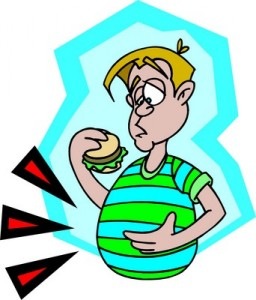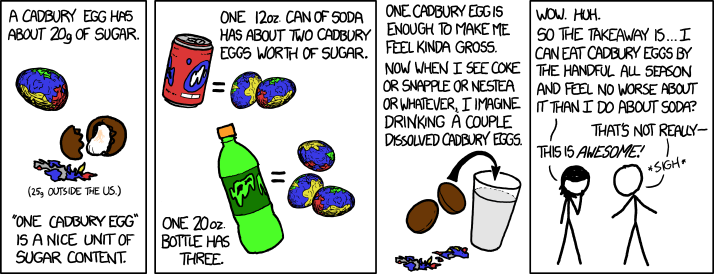Food for Fun and Thought
I’m Lookin’ For My PEEPS
 Lots of people have a thing for those fluorescent marshmallow bunnies and chicks that were hatched over 50 years ago. They got their name – PEEPS — because the original candy was the yellow chick. Now they’re produced for many holidays – in seasonal colors and different shapes.
Lots of people have a thing for those fluorescent marshmallow bunnies and chicks that were hatched over 50 years ago. They got their name – PEEPS — because the original candy was the yellow chick. Now they’re produced for many holidays – in seasonal colors and different shapes.
They continue to be the subject of lots of design contests (you’d be amazed what you can make out of peeps) and scientific experiments (some claim them to be indestructible). Just Born, the parent company of PEEPS, claims to produce enough PEEPS in one year to circle the Earth twice. Their website boasts a fan club and a section for recipes.
PEEPS have been the number one non-chocolate Easter candy in the US for more than a decade. Although yellow is America’s favorite color for PEEPS chicks and bunnies, they also come in pink, lavender, blue, orange and green. This year there are rainbow PEEPS pops and chocolate dipped mousse flavored mashmallow chicks.
What’s In Them?
Send a PEEP for lab analysis and you’ll find sugar, corn syrup, gelatin, less than 0.5% of potassium sorbate, natural flavors, dye, and carnauba wax. They’re gluten and nut free. (No wonder some claim that they’re indestructible!) You can even get sugar free PEEPS that are made with Splenda.
Five little chicks (42g, one serving size): 140 calories; 0g fat; 1g protein; and 36g carbs.
PEEPS Preferences
People have definite PEEPS preferences. Some like them nice and soft, others leave them out in the air to age to perfection so they get a little crunchy on the outside.
They’ve been microwaved (careful, they expand and can really make a mess in your microwave), frozen, roasted, used to top hot chocolate, and added to recipes. They don’t toast well on sticks like regular marshmallows because their outer sugar coating tends to burn.
Newspapers have been known to run contests for best PEEP recipes and best PEEP pictures, and, in a world of contrasts I’ve seen a blackboard outside of a bar in NYC advertising a PEEP contest and a JCrew (Crewcuts) kids’ store using boxes and boxes of PEEPs for window decoration.
I have a few members of my family who love their PEEPS and I freely admit that I am not one of them — although I do think they make great table decorations.
If PEEPS are part of your Easter ritual, even though they’re filled with sugar and all kinds of dyes and chemicals — if you’re counting calories and fat grams — for a seasonal treat, you could do worse.
What’s your PEEPS preference?
Two Easters And Passover: Which Is When?
 In 2012, Easter will be celebrated on April 8th by Western churches and on April 15th by Orthodox churches. In 2011, both were celebrated on the same day, April 24th. In 2013, Western Christian Easter will be celebrated on March 31st and Orthodox Easter will be on May 5th. The holiday of Pesach, or Passover, falls on the Hebrew calendar dates of Nissan 15-22 or the secular dates of April 6th – 14th in 2012 and March 25th – April 2nd in 2013.
In 2012, Easter will be celebrated on April 8th by Western churches and on April 15th by Orthodox churches. In 2011, both were celebrated on the same day, April 24th. In 2013, Western Christian Easter will be celebrated on March 31st and Orthodox Easter will be on May 5th. The holiday of Pesach, or Passover, falls on the Hebrew calendar dates of Nissan 15-22 or the secular dates of April 6th – 14th in 2012 and March 25th – April 2nd in 2013.
How Do You Know The Dates For The Holidays?
The easiest way to figure out the dates for Easter and Passover is to look them up – unless, of course, you are a trained astronomer or someone else whose been taught how to calculate the moveable dates.
Growing up, I was always caught in a holiday vacation snare. I went to a Greek elementary school. Vacation was Holy Week and Easter Week for Greek (Eastern Orthodox) Easter. My neighborhood friends, most of whom went to Catholic school, had off Holy Week and Easter Week for Western Christian Easter. My birthday, at the end of March, usually fell during someone’s vacation – but since my friends and I had different ones – my birthday celebration was shared only with the kids that were around. That really used to annoy me.
As a child I remember being taught that Orthodox Easter was based on the lunar calendar – like Passover – and that Christian Easter was not. This was neither a very good nor an accurate explanation.
So finally, many years later, I decided to look it up – and I’m sharing the explanation with you.
The Formula For The Holiday Date Calculation
Both Western and Orthodox churches use the same formula to calculate the date for Easter: the first Sunday after the first full moon on or after the vernal equinox. The problem is that they base the dates on different calendars: Western churches use the Gregorian calendar, the standard calendar used in most of the world. Orthodox churches use the older Julian calendar.
Along with the two different calendar systems there’s a factoring in of ecclesiastical moons and paschal full moons, the astronomical equinox, and the fixed equinox.
The Dates
The Christian churches that follow the Gregorian calendar celebrate Easter on the first Sunday after the paschal full moon on or just after the vernal equinox, March 21. The paschal full Moon is always on the 14th day of a lunar month.
Eastern Orthodox churches follow the Julian calendar. Because of different methods of calculation, the Eastern Orthodox and Western Christian churches frequently celebrate Easter on different days.
In Western Christian churches Easter cannot be before March 22nd or after April 25th. In Eastern churches, using Gregorian calendar dates, Easter can occur between April 4th and May 8th.
Passover Dates In Relationship To Easter
The Eastern Orthodox Church applies the calendar formula so that Easter always falls after Passover believing that the Crucifixion and Resurrection of Christ took place after he entered Jerusalem to celebrate Passover. Easter sometimes precedes Passover by weeks in the Western Church.
Jelly Beans: What Kind Is Your Favorite?
 Don’t you love those little nuggets of jelly bean sweetness that come in multitudes of colors and flavors and get stuck in your teeth?
Don’t you love those little nuggets of jelly bean sweetness that come in multitudes of colors and flavors and get stuck in your teeth?
Their gummy insides probably stretch back centuries ago from the treat, Turkish Delight. Their outsides are just like the colored hard candy coating, developed in the late 17th century, for the Jordan almond.
The modern jelly bean became popular during the American Civil War when Boston’s William Schraft encouraged sending candy to Union soldiers. Jellybeans were the first bulk candy and they became one of the staples of penny candy that was sold by weight in the early 1900s. Because of their egg shape, which can be taken as representing fertility and birth, they became popular as Easter candy around 1930.
Standard jelly beans come in fruit flavors but there are now a huge number of flavors — some goofy, some sophisticated — like spiced, mint, gourmet, tropical, popcorn, bubble gum, pepper, and cola. They also come in a sugar free version (seems weird, but true – don’t you wonder how many chemicals are in those). Whatever your flavor preference, Americans eat a whole lot of them – around 16 billion at Easter enough to circle the globe nearly three times if all of the Easter jellybeans were lined up end to end.
How Do You Eat Them And What’s Your Flavor?
My preference (and my downfall) is to gobble up small handfuls (mostly reds and pinks) at a time — one reason I can’t have them in the house. How do stack up against these stats?
- 70% of kids aged 6–11 say they prefer to eat Easter jellybeans one at a time
- 23% say they eat several at once
- Boys (29%) are more likely to eat a handful than girls (18%)
- Kids say their favorite Easter jellybean flavors are cherry (20%), strawberry (12%), grape (10%), lime (7%), and blueberry (6%).
What’s In Jelly Beans?
They’re primarily made of sugar and also usually contain gelatin, corn syrup, modified food starch, and less than 0.5% of citric acid, sodium citrate, artificial flavors, confectioners glaze, pectin, carnauba wax, white mineral oil, magnesium hydroxide, and artificial colors (takes some of the fun out of them, doesn’t it).
Even though they may give you Technicolor insides, they are fat free. On average:
- 10 small jelly beans (11g) have 41 calories, no fat, no cholesterol, no protein, and 10.3 grams of carbs
- 10 large jelly beans (1 oz or 28g) have 105 calories, no fat, no cholesterol, no protein, and 26.2g carbs
- 10 Jelly Bellies have 40 calories, no fat, no protein, and 10g carbs
Some Jelly Belly Jelly Bean Trivia
- Jelly Bellys were invented in 1976. They were the first jelly beans to be sold in single flavors and to come with a menu of flavor choices.
- It takes 7 to 21 days to make a single Jelly Belly jelly bean.
- Very Cherry was the most popular Jelly Belly flavor for two decades until 1998, when Buttered Popcorn took over. Very Cherry moved back into the top spot by only 8 million beans in 2003.
- Jelly Bellies were the first jelly beans in outer space – they were sent on the 1983 flight of the space shuttle Challenger by President Reagan.
Do You Still Eat More Even When Your Stomach Is Full And Your Pants Are Tight?
 Have you ever had a day when it seems like all you do is eat and eat and eat some more? You eat everything – a bagel for breakfast, a donut for a midmorning snack, and at lunch with friends or coworkers and before you know it the breadbasket is empty. You might follow it up by some coffee and a snack in the afternoon. Maybe it’s a workday and you amble down to the hall to the vending machine or the snack room only to find that it’s someone’s birthday so there’s that delicious birthday cake sitting in the middle of the table. A little nibble of some cheese around six. Uh oh. Dinner plans that night – how can you eat even more?
Have you ever had a day when it seems like all you do is eat and eat and eat some more? You eat everything – a bagel for breakfast, a donut for a midmorning snack, and at lunch with friends or coworkers and before you know it the breadbasket is empty. You might follow it up by some coffee and a snack in the afternoon. Maybe it’s a workday and you amble down to the hall to the vending machine or the snack room only to find that it’s someone’s birthday so there’s that delicious birthday cake sitting in the middle of the table. A little nibble of some cheese around six. Uh oh. Dinner plans that night – how can you eat even more?
There Always Seems To Be Room
You get to the restaurant. It’s gotten a great review and you’re with good company, too. How can you not go for it? The food is supposed to be phenomenal. You’re not hungry, but you eat and eat. Appetizer, bread, salad, entrée. Stuffed and double stuffed. Then it’s time for dessert and it sounds so appealing. The chocolate lava cake or the key lime pie is what this restaurant is known for. You really feel like you can’t stuff in another morsel, but guess what – you order one of the spectacular choices and eat it – every last fork full including the crumbs.
Why Do You Continue To Eat?
The signal to stop eating is usually not because your stomach is full (except in some extreme cases). According to Brian Wansink, PhD, author of the book, Mindless Eating, a combination of things like how much you taste, chew, swallow, how much you think about the food you are eating, and how long you’ve been eating all come into play.
Incredibly, the faster most people eat, the more they eat. Eating quickly doesn’t give your brain the chance to get the message that you’re not hungry any more. Research shows that it takes up to 20 minutes for your body and brain to both get the message — the satiation signal — and realize that you’re full. Think how much more you can eat in that time span of 20 minutes – a burger, fries, pie, pizza, ice cream – even though your stomach is really full but your brain may not yet have gotten the message.
Twenty Minutes Or Less
Research has shown that Americans start and finish their meals — and clear the table — in less than 20 minutes. A study published in the journal Appetite found that people eating lunch by themselves in a fast food restaurant finish in 11 minutes. It takes 13 minutes to finish in a workplace cafeteria and 28 minutes at a moderately priced restaurant. Eating with three other people takes about twice as long – which can still end up being a really short chunk of time.
Some Strategies
- Slow down when you eat. Give your brain a chance to catch up. How many times have you devoured what you’ve made or bought for lunch in almost no time flat — and then, almost immediately, decided that you’re still hungry? Twenty minutes to half an hour after you’ve ended up eating a whole bunch more — even though your stomach is probably full — your belly feels like it’s going to explode and you can’t, in good conscience — unbutton any more buttons on your pants. You realize that you should have stopped before the seconds.
- Eat more slowly, chew more thoroughly, pace your whole eating pattern to a slower beat. Give your brain a chance to synch its signals with the messages generated by putting food in your stomach.
- Try getting up from the table and doing something else – and promise yourself if you’re still hungry in 20 minutes you can have more. If you’re in a restaurant, it’s the perfect time to excuse yourself and go to the rest room or claim that you have to make a call.
In most cases, after the 20 or so minutes, your belly and brain are both happy and in synch and you won’t want more to eat. What you save: excess calories and an uncomfortably expanding stomach.
